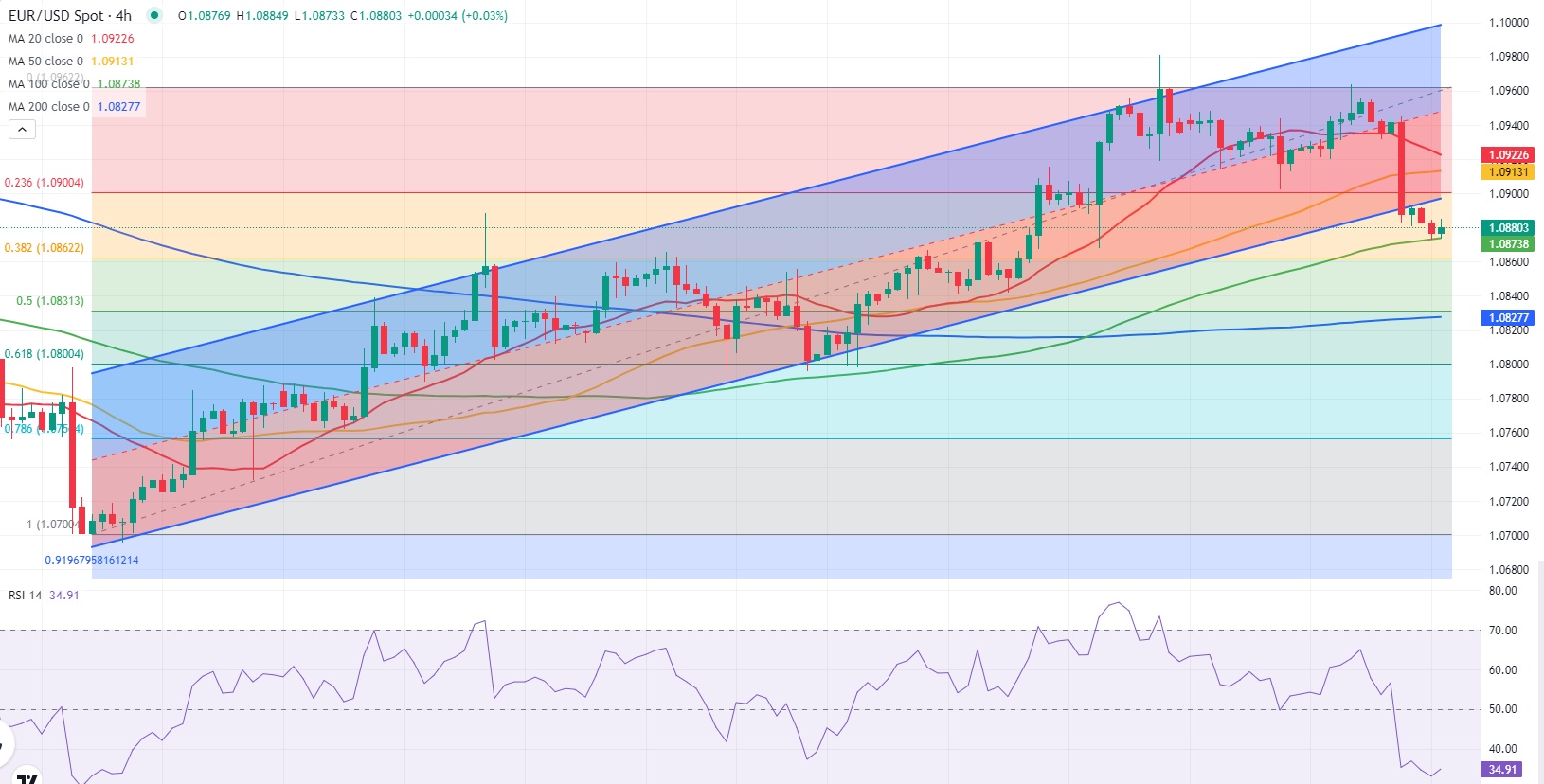- EUR/USD trades below 1.0900 after posting large losses on Thursday.
- Near-term technical outlook points to a bearish tilt.
- The pair needs to reclaim 1.0900 to discourage sellers.
EUR/USD came under heavy bearish pressure and closed below 1.0900 on Thursday. The pair stays relatively calm but struggles to gather recovery momentum early Friday.
After the data from the US showed that producer inflation, as measured by the change in the Producer Price Index (PPI), climbed to 1.6% on a yearly basis in February from 1% in January, the benchmark 10-year US Treasury bond yield surged higher and provided a boost to the US Dollar (USD). According to the CME FedWatch Tool, the probability of the Federal Reserve leaving the policy rate unchanged at June meeting climbed to 40% after the PPI data, compared to nearly 25% earlier in the week.
Euro price this week
The table below shows the percentage change of Euro (EUR) against listed major currencies this week. Euro was the weakest against the US Dollar.
| USD | EUR | GBP | CAD | AUD | JPY | NZD | CHF | |
| USD | 0.58% | 0.94% | 0.44% | 0.98% | 1.23% | 1.32% | 0.83% | |
| EUR | -0.58% | 0.38% | -0.14% | 0.40% | 0.67% | 0.75% | 0.26% | |
| GBP | -0.95% | -0.37% | -0.50% | 0.04% | 0.31% | 0.39% | -0.09% | |
| CAD | -0.43% | 0.13% | 0.49% | 0.54% | 0.78% | 0.88% | 0.39% | |
| AUD | -0.99% | -0.41% | -0.05% | -0.54% | 0.25% | 0.34% | -0.14% | |
| JPY | -1.23% | -0.66% | -0.05% | -0.80% | -0.24% | 0.09% | -0.40% | |
| NZD | -1.33% | -0.75% | -0.39% | -0.90% | -0.34% | -0.09% | -0.49% | |
| CHF | -0.84% | -0.26% | 0.10% | -0.39% | 0.12% | 0.38% | 0.49% |
The heat map shows percentage changes of major currencies against each other. The base currency is picked from the left column, while the quote currency is picked from the top row. For example, if you pick the Euro from the left column and move along the horizontal line to the Japanese Yen, the percentage change displayed in the box will represent EUR (base)/JPY (quote).
Later in the day, the US economic docket will feature Import Price Index and Export Price Index figures for February. Although these data usually don't trigger a noticeable market reaction, a positive reading in the Import Price Index, which was down 1.3% on a yearly basis in January, could help the USD preserve its strength heading into the weekend.
The University of Michigan (UoM) will release the preliminary Consumer Sentiment Survey for March as well on Friday. The Consumer Confidence Index is forecast to remain unchanged at 76.9. Investors will also pay close attention to the one-year and five-year inflation expectation components of the survey.
EUR/USD Technical Analysis
EUR/USD broke below the ascending regression channel and the Relative Strength Index (RSI) indicator on the 4-hour chart dropped below 40, highlighting a buildup of bearish pressure.
On the downside, a strong support area seems to have formed at 1.0870-1.0860, where the 100-period Simple Moving Average (SMA) meets the Fibonacci 38.2% retracement level of the latest uptrend. If the pair falls below that level and starts using it as resistance, 1.0830 (200-period SMA, Fibonacci 50% retracement) could be seen as the next bearish target before 1.0800 (Fibonacci 61.8% retracement).
1.0900 (lower limit of the ascending channel) aligns as key resistance. In case the pair manages to stabilize above that level, sellers could be discouraged. In this scenario, 1.0920 (20-period SMA, 50-period SMA) could act as interim resistance before 1.0950 (mid-point of the ascending channel).
Euro FAQs
The Euro is the currency for the 20 European Union countries that belong to the Eurozone. It is the second most heavily traded currency in the world behind the US Dollar. In 2022, it accounted for 31% of all foreign exchange transactions, with an average daily turnover of over $2.2 trillion a day. EUR/USD is the most heavily traded currency pair in the world, accounting for an estimated 30% off all transactions, followed by EUR/JPY (4%), EUR/GBP (3%) and EUR/AUD (2%).
The European Central Bank (ECB) in Frankfurt, Germany, is the reserve bank for the Eurozone. The ECB sets interest rates and manages monetary policy. The ECB’s primary mandate is to maintain price stability, which means either controlling inflation or stimulating growth. Its primary tool is the raising or lowering of interest rates. Relatively high interest rates – or the expectation of higher rates – will usually benefit the Euro and vice versa. The ECB Governing Council makes monetary policy decisions at meetings held eight times a year. Decisions are made by heads of the Eurozone national banks and six permanent members, including the President of the ECB, Christine Lagarde.
Eurozone inflation data, measured by the Harmonized Index of Consumer Prices (HICP), is an important econometric for the Euro. If inflation rises more than expected, especially if above the ECB’s 2% target, it obliges the ECB to raise interest rates to bring it back under control. Relatively high interest rates compared to its counterparts will usually benefit the Euro, as it makes the region more attractive as a place for global investors to park their money.
Data releases gauge the health of the economy and can impact on the Euro. Indicators such as GDP, Manufacturing and Services PMIs, employment, and consumer sentiment surveys can all influence the direction of the single currency. A strong economy is good for the Euro. Not only does it attract more foreign investment but it may encourage the ECB to put up interest rates, which will directly strengthen the Euro. Otherwise, if economic data is weak, the Euro is likely to fall. Economic data for the four largest economies in the euro area (Germany, France, Italy and Spain) are especially significant, as they account for 75% of the Eurozone’s economy.
Another significant data release for the Euro is the Trade Balance. This indicator measures the difference between what a country earns from its exports and what it spends on imports over a given period. If a country produces highly sought after exports then its currency will gain in value purely from the extra demand created from foreign buyers seeking to purchase these goods. Therefore, a positive net Trade Balance strengthens a currency and vice versa for a negative balance.
Information on these pages contains forward-looking statements that involve risks and uncertainties. Markets and instruments profiled on this page are for informational purposes only and should not in any way come across as a recommendation to buy or sell in these assets. You should do your own thorough research before making any investment decisions. FXStreet does not in any way guarantee that this information is free from mistakes, errors, or material misstatements. It also does not guarantee that this information is of a timely nature. Investing in Open Markets involves a great deal of risk, including the loss of all or a portion of your investment, as well as emotional distress. All risks, losses and costs associated with investing, including total loss of principal, are your responsibility. The views and opinions expressed in this article are those of the authors and do not necessarily reflect the official policy or position of FXStreet nor its advertisers. The author will not be held responsible for information that is found at the end of links posted on this page.
If not otherwise explicitly mentioned in the body of the article, at the time of writing, the author has no position in any stock mentioned in this article and no business relationship with any company mentioned. The author has not received compensation for writing this article, other than from FXStreet.
FXStreet and the author do not provide personalized recommendations. The author makes no representations as to the accuracy, completeness, or suitability of this information. FXStreet and the author will not be liable for any errors, omissions or any losses, injuries or damages arising from this information and its display or use. Errors and omissions excepted.
The author and FXStreet are not registered investment advisors and nothing in this article is intended to be investment advice.
Recommended Content
Editors’ Picks

AUD/USD holds above mid-0.6300s amid mixed fundamental cues
AUD/USD consolidates near the weekly low touched on Wednesday amid fading optimism over a quick resolution to the US-China trade dispute. Moreover, easing concerns about the Fed's independence assists the USD to preserve its recovery gains registered over the past two days and acts as a headwind for the currency pair.

EUR/USD strengthens above 1.1300 on gloomy Fed’s Beige Book
The EUR/USD pair edges higher to around 1.1335 during the early Asian session on Thursday. Mitigating concerns over potential tariff threats by US President Donald Trump exerts some selling pressure on the US Dollar.

Gold corrected extreme conditions, struggles around $3,300
Gold extended its decline on Wednesday, slipping below the $3,300 mark per troy ounce in response to reports from the media suggesting the Trump administration is weighing tariff reductions on Chinese goods, a news that revived hopes of easing trade tensions and reduced demand for the yellow metal as a safe-haven asset.

TRUMP meme coin rallies following announcement of President Trump's upcoming dinner with top 220 holders
Official TRUMP rallied 50% on Wednesday after the team behind the meme coin announced plans for its top 220 token holders to have a dinner with President Donald Trump in May. The announcement also included an extension of the token's initial unlock plan by an additional 90 days.

Five fundamentals for the week: Traders confront the trade war, important surveys, key Fed speech Premium
Will the US strike a trade deal with Japan? That would be positive progress. However, recent developments are not that positive, and there's only one certainty: headlines will dominate markets. Fresh US economic data is also of interest.

The Best brokers to trade EUR/USD
SPONSORED Discover the top brokers for trading EUR/USD in 2025. Our list features brokers with competitive spreads, fast execution, and powerful platforms. Whether you're a beginner or an expert, find the right partner to navigate the dynamic Forex market.
